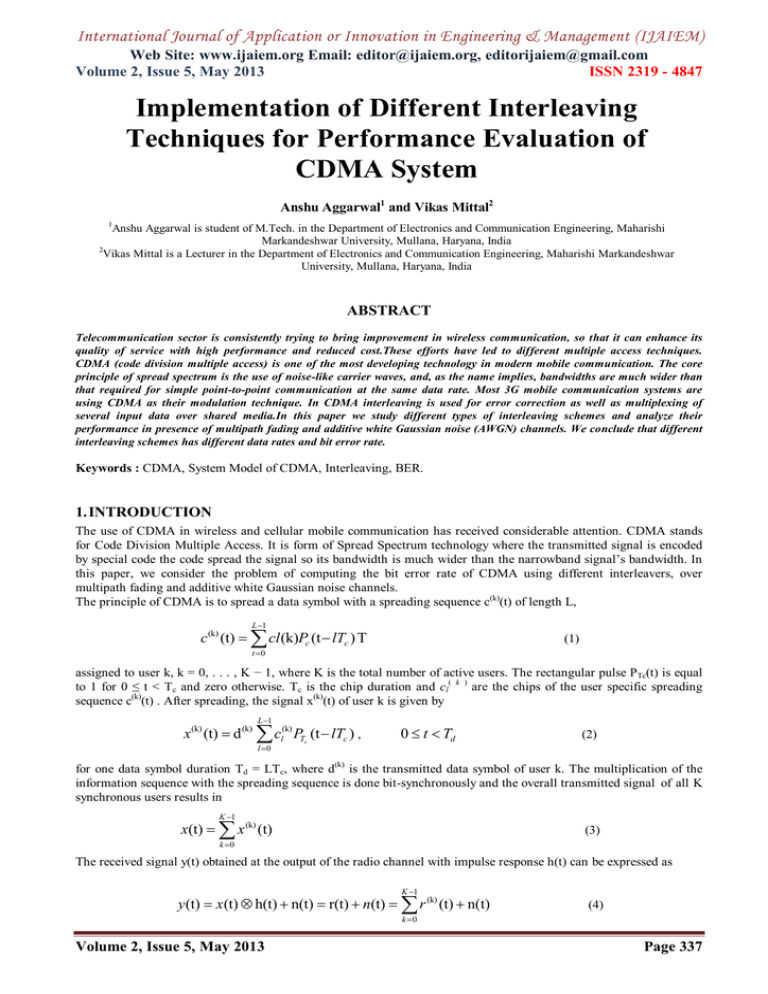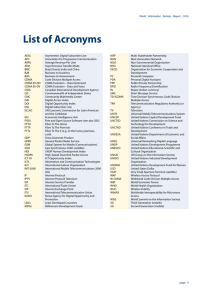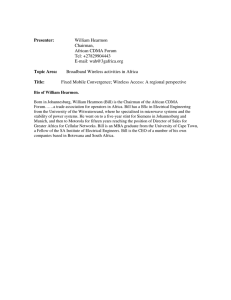International Journal of Application or Innovation in Engineering & Management... Web Site: www.ijaiem.org Email: , Volume 2, Issue 5, May 2013
advertisement

International Journal of Application or Innovation in Engineering & Management (IJAIEM) Web Site: www.ijaiem.org Email: editor@ijaiem.org, editorijaiem@gmail.com Volume 2, Issue 5, May 2013 ISSN 2319 - 4847 Implementation of Different Interleaving Techniques for Performance Evaluation of CDMA System Anshu Aggarwal1 and Vikas Mittal2 1 Anshu Aggarwal is student of M.Tech. in the Department of Electronics and Communication Engineering, Maharishi Markandeshwar University, Mullana, Haryana, India 2 Vikas Mittal is a Lecturer in the Department of Electronics and Communication Engineering, Maharishi Markandeshwar University, Mullana, Haryana, India ABSTRACT Telecommunication sector is consistently trying to bring improvement in wireless communication, so that it can enhance its quality of service with high performance and reduced cost.These efforts have led to different multiple access techniques. CDMA (code division multiple access) is one of the most developing technology in modern mobile communication. The core principle of spread spectrum is the use of noise-like carrier waves, and, as the name implies, bandwidths are much wider than that required for simple point-to-point communication at the same data rate. Most 3G mobile communication systems are using CDMA as their modulation technique. In CDMA interleaving is used for error correction as well as multiplexing of several input data over shared media.In this paper we study different types of interleaving schemes and analyze their performance in presence of multipath fading and additive white Gaussian noise (AWGN) channels. We conclude that different interleaving schemes has different data rates and bit error rate. Keywords : CDMA, System Model of CDMA, Interleaving, BER. 1. INTRODUCTION The use of CDMA in wireless and cellular mobile communication has received considerable attention. CDMA stands for Code Division Multiple Access. It is form of Spread Spectrum technology where the transmitted signal is encoded by special code the code spread the signal so its bandwidth is much wider than the narrowband signal’s bandwidth. In this paper, we consider the problem of computing the bit error rate of CDMA using different interleavers, over multipath fading and additive white Gaussian noise channels. The principle of CDMA is to spread a data symbol with a spreading sequence c(k)(t) of length L, L 1 c (k) (t) cl (k)Pc (t lTc ) T (1) t 0 assigned to user k, k = 0, . . . , K − 1, where K is the total number of active users. The rectangular pulse PTc(t) is equal to 1 for 0 ≤ t < Tc and zero otherwise. Tc is the chip duration and cl( k ) are the chips of the user specific spreading sequence c(k)(t) . After spreading, the signal x(k)(t) of user k is given by L 1 x (k) (t) d (k) cl(k) PTc (t lTc ) , 0 t Td (2) l 0 for one data symbol duration Td = LTc, where d(k) is the transmitted data symbol of user k. The multiplication of the information sequence with the spreading sequence is done bit-synchronously and the overall transmitted signal of all K synchronous users results in K 1 x(t) x (k) (t) (3) k 0 The received signal y(t) obtained at the output of the radio channel with impulse response h(t) can be expressed as K 1 y (t) x (t) h(t) n(t) r(t) n(t) r (k) (t) n(t) (4) k 0 Volume 2, Issue 5, May 2013 Page 337 International Journal of Application or Innovation in Engineering & Management (IJAIEM) Web Site: www.ijaiem.org Email: editor@ijaiem.org, editorijaiem@gmail.com Volume 2, Issue 5, May 2013 ISSN 2319 - 4847 where is r (t) x(t) h(t) the noise-free received signal of user k, n(t) is the additive white Gaussian noise (AWGN), and denotes the convolution operation. The impulse response of the matched filter (MF) hMF(k) (t) in the receiver of user k is adapted to both the transmitted waveform including the spreading sequence c(k)(t) and to the channel impulse response h(t), (k) hMF (t) c(k) ( t) h ( t) (5) The notation X* denotes the conjugate of the complex value x. Finally, threshold detection is performed to obtain the estimated information symbol. Ideally, the matched filter receiver resolves all multipath propagation in the channel[1]. In practice a good approximation of a matched filter receiver is a rake receiver. A rake receiver has D arms to resolve D echoes where D might be limited by the implementation complexity. In each arm d, d = 0, . . . ,D − 1, the received signal y(t) is delayed and despread with the code c(k)(t) assigned to user k and weighted with the conjugate instantaneous value hd* , d = 0, . . . ,D − 1, of the time-varying complex channel attenuation of the assigned echo. Finally, the rake receiver combines the results obtained from each arm and makes a final decision. 2. SYSTEM MODEL OF CDMA This paper is concerned with the calculation of the bit error rate of a CDMA in a multipath fading and additive white Gaussian noise channels that is modeled by a discrete set of Rayleigh faded paths. Figure 1 shows a CDMA transmitter. It consists of a forward error correction (FEC) encoder, mapping, spreader, pulse shaper, and analog front-end. Channel coding is required to protect the transmitted data against channel errors. The encoded and mapped data are spread with the code c(k)(t) over a much wider bandwidth than the bandwidth of the information signal. As the power of the output signal is distributed over a wide bandwidth, the power density of the output signal is much lower than that of the input signal. The General CRC Generator block generates cyclic redundancy code (CRC) bits for each input data frame and appends them to the frame. The Convolutional Encoder block encodes a sequence of binary input vectors to produce a sequence of binary output vectors. This block can process multiple symbols at a time. Figure 1. CDMA Transmitter Convolutional codes are one of the most widely used channel codes in practical communication systems. These codes are developed with a separate strong mathematical structure and are primarily used for real time error correction. Convolutional codes convert the entire data stream into one single codeword. It is a type of forward error correction (FEC) which its function is to improve the capacity of a channel by adding redundant information to the data being transmitted through the channel[3]. Convolutional codes are usually described using two parameters: the code rate and the constraint length. The code rate, k/n, is expressed as a ratio of the number of bits into the convolutional encoder (k) to the number of channel symbols output by the convolutional encoder (n) in a given encoder cycle. Constraint length denotes how many k-bit stages are available to feed the combinatorial logic that produces the output symbols. The General Block Interleaver block rearranges the elements of its input vector without repeating or omitting any elements. The input can be real or complex. If Elements is [4,1,3,2] and the input vector is [40;32;59;1], then the output vector is [1;40;59;32]. Figure 2 shows a CDMA receiver. The received signal is first filtered and then digitally converted with a sampling rate of 1/Tc. It is followed by a rake receiver. The rake receiver is necessary to combat multipath, i.e., to combine the power of each received echo path. The echo paths are detected with a resolution of Tc. Therefore, each received signal of each path is delayed by lTc and correlated with the assigned code sequence. The total number of resolution paths depends on Volume 2, Issue 5, May 2013 Page 338 International Journal of Application or Innovation in Engineering & Management (IJAIEM) Web Site: www.ijaiem.org Email: editor@ijaiem.org, editorijaiem@gmail.com Volume 2, Issue 5, May 2013 ISSN 2319 - 4847 the processing gain. After correlation, the power of all detected paths are combined and, finally, the demapping and FEC decoding are performed to assure the data integrity. Figure 2. CDMA Receiver Viterbi decoding is one of two types of decoding algorithms used with convolutional encoding. The other type is sequential decoding. Viterbi decoding essentially performs the maximum likelihood decoding. It reduces the computational load by taking advantage of special structure in code trellis. The Viterbi decoder computes a metric for each path and makes a decision based on this metric. All paths are followed until two paths converge on one node. Then the path with the higher metric is kept and the one with lower metric is discarded. The paths selected are called the survivors. In order for Viterbi algorithm to work properly, several requirements have to be met which are that the transmitter has to make sure that the encoder starts and stops in the zero state. Zero state means that all the shift registers contains all zeros and no ones. Thus the transmitter will appends m zeros at the end of the information bits to flush the encoder and the receiver can always assume that it is safe to start and end in the zero state of the trellis. Since the decoding procedure will make decision based on the most probable sequence thus the depth of the decoding trellis must also be specified. The general idea is that the depth is not exceeding five times the constraint length. 3. CDMA INTERLEAVING SCHEMES Interleaving is a way to arrange data in a non- contiguous way to increase performance. It is typically used in errorcorrection coding, particularly within data transmission, for multiplexing of several input data over shared media. In telecommunication, it is implemented through dynamic bandwidth allocation mechanisms, where it may particularly be used to resolve quality of service and latency issues. In streaming media applications, it enables quasisimultaneous reception of input streams, such as video and audio. In CDMA different type of interleaving schemes can be used such as: Block Interleaver The Block Interleaver rearranges the elements of its input without repeating or omitting any elements. The input can be real or complex. If the input contains N elements, then the Elements parameter is a vector of length N that indicates the indices, in order, of the input elements that form the length-N output vector. For example, if Elements is [4,1,3,2] and the input is [40;32;59;1], then the output vector is [1;40;59;32]. Convolutional Interleaver A convolutional interleaver consists of a set of shift registers, each with a fixed delay. In a typical convolutional interleaver, the delays are nonnegative integer multiples of a fixed integer[5]. Each new symbol from an input vector feeds into the next shift register and the oldest symbol in that register becomes part of the output vector. A convolutional interleaver has memory; that is, its operation depends not only on current symbols but also on previous symbols[6]. Matrix Interleaver The Matrix Interleaver block performs block interleaving by filling a matrix with the input symbols row by row and then sending the matrix contents to the output port column by column. The Number of rows and Number of columns Volume 2, Issue 5, May 2013 Page 339 International Journal of Application or Innovation in Engineering & Management (IJAIEM) Web Site: www.ijaiem.org Email: editor@ijaiem.org, editorijaiem@gmail.com Volume 2, Issue 5, May 2013 ISSN 2319 - 4847 parameters are the dimensions of the matrix that the block uses internally for its computations. For example, if the Number of rows and Number of columns parameters are 2 and 3, respectively, then the interleaver uses a 2-by-3 matrix for its internal computations. Given an input signal of [1; 2; 3; 4; 5;6], the block produces an output of [1; 4; 2; 5; 3;6]. Random Interleaver The Random Interleaver block rearranges the elements of its input vector using a random permutation. The Number of elements parameter indicates how many numbers are in the input vector. If the input is frame-based, then it must be a column vector[8]. 4. PERFORMANCE ANALYSIS OF INTERLEAVING SCHEMES CDMA performance analysis presented in this section is based on computer simulations. The basic scenario of our simulation is represented by the CDMA transmission system performing through multipath fading and AWGN transmission channel, at sample time (20e-3*1)/44 and 44 samples per frame. As the spreading sequences, Walsh codes with period of 64 chips is used. The simulation results of CDMA system is shown below: Figure 3. CDMA Transmitted Signal Figure 4. CDMA Received Signal Figure 5. Scatter Plot of CDMA Transmitted Signal Volume 2, Issue 5, May 2013 Page 340 International Journal of Application or Innovation in Engineering & Management (IJAIEM) Web Site: www.ijaiem.org Email: editor@ijaiem.org, editorijaiem@gmail.com Volume 2, Issue 5, May 2013 ISSN 2319 - 4847 Figure 6. Scatter Plot of CDMA Received Signal Figure 4 shows the CDMA transmitted signal to the channel. This signal is passed through the multipath fading and additive white Gaussian noise channel. After passing this signal from channel we get the CDMA received signal as shown in Figure 5 which is full of distortions. Figure 6 shows the scatter plot of transmitted signal of CDMA system. The scatter plot is used to reveal the modulation characteristics, such as pulse shaping or channel distortions of the signal. Similarly Figure 7 shows the scatter plot of CDMA received signal. The scatter plot illustrates the effect of fading on the signal constellation. For all the interleaving schemes the transmitted and received signal has same bandwidth but these schemes effect the transmission rate and bit error rate of CDMA system. These effect of interleaving schemes is shown in tabular form in Table 1. Table1 - BER obtained with different interleaving techniques Interleaver Total Bits Bit Loss Bit Error Transmitted Rate (BER) 42830 21490 .5018 Block Interleaver Convolutional 42830 2564 .0590 Interleaver Random 42830 21450 .5008 Interleaver On comparing these interleaving schemes we get that the transmission rate of all the interleaving schemes used in CDMA system is same but the bit error rate if different. From all these interleaving schemes convolutional interleaving scheme is best suitable for CDMA system because it has very low bit error rate as compare to other schemes. 5. CDMA ENCODING SCHEME In CDMA system we generally use CRC (Cyclic Redundancy Code) - CRC Encoding: The General CRC Generator block generates cyclic redundancy code (CRC) bits for each input data frame and appends them to the frame. 6. CONCLUSION In CDMA interleaving is used for multiplexing of several input data over shared media. Interleaving is a technique for randomizing the bits in a message stream so that burst errors introduced by the channel can be converted to random errors.In CDMA system different type of interleaving schemes are used. The transmission bandwidth of the CDMA system with all these interleaving schemes is same. But in a transmission system main concern is on efficient transmission i.e. number of errors or distortion is less. So CDMA system with convolutional interleaving is more efficient because it has less BER as compared to other interleaving schemes So we conclude that between all these interleaving schemes CDMA system achieves better BER results with convolutional interleaving. Volume 2, Issue 5, May 2013 Page 341 International Journal of Application or Innovation in Engineering & Management (IJAIEM) Web Site: www.ijaiem.org Email: editor@ijaiem.org, editorijaiem@gmail.com Volume 2, Issue 5, May 2013 ISSN 2319 - 4847 REFERENCES [1.] K. Fazel & S. keiser, “Multi Carrier and Spread Spectrum Systems” 1st ed., England: John Wiley and Sons Limited, pp. 30 – 37, 2003. [2.] R. Michael Buehrer, “Code Division Multiple Access”, Morgan & Claypool Publishers, pp. 23 – 39, 2006. [3.] Clark, George C. Jr. and J. Bibb Cain, “Error-Correction Coding for Digital Communications”, New York: Plenum Press, 1981. [4.] Heller, Jerrold A. and Irwin Mark Jacob, "Viterbi Decoding for Satellite and Space Communication." IEEE Transactions on Communication Technology, vol. COM-19, pp. 835 – 848, October 1971. [5.] Ramsey, J. L., "Realization of Optimum Interleavers.", IEEE Transactions on Information Theory, IT-16 (3), pp. 338 – 345, May 1970. [6.] Forney, G., D., Jr., "Burst-Correcting Codes for the Classic Bursty Channel.", IEEE Transactions on Communications, vol. COM-19, pp. 772 – 781, October 1971. [7.] Berlekamp, E. R. and P. Tong., "Improved Interleavers for Algebraic Block Codes." U. S. Patent 4559625, Dec. 17, 1985. [8.] Heegard, Chris and Stephen B. Wicker. Turbo Coding. Boston: Kluwer Academic Publishers, 1999. [9.] Clark, George C. Jr. and J. Bibb Cain, “Error-Correction Coding for Digital Communications” New York: Plenum Press, 1981. [10.] Chang, L.F.; Sollenberger, N., "Comparison of two interleaving techniques for CDMA radio communications systems," Vehicular Technology Conference, 1992, IEEE 42nd [11.] Yunlong Cai; De Lamare, R.C.; Rui Fa, "Novel Switched Interleaving Techniques with Limited Feedback for DSCDMA Systems," Communications, 2009. ICC '09. IEEE International Conference on , vol., no., pp.1,5, 14-18 June 2009 [12.] Yunlong Cai; de Lamare, R.C.; Rui Fa, "Switched Interleaving Techniques with Limited Feedback for Interference Mitigation in DS-CDMA Systems," Communications, IEEE Transactions on , vol.59, no.7, pp.1946,1956, July 2011 Volume 2, Issue 5, May 2013 Page 342



